Last October, directly before a great darkness befell the land and winter cascaded from the sky across the American heartland and melted beneath our feet as we batted our eyelashes in the wind, we invited you to take a very long survey. We wanted to know things. Things about you. Things about how you felt about us. And oh! Oh did you tell us how you felt. You feel so many things, and we felt your feelings, and those feelings informed the work we do.
We wanted to know more, though, which is why a couple weeks ago we kindly requested your participation in a shorter survey — the 2017 Autostraddle Reader Mini-Survey. This helped us do our jobs during our annual Senior Staff week-long meeting (the only time of year when we’re all able to work in the same room), but you’re welcome to take it now if you haven’t already! I promised you then that I’d give you more information about the results of last year’s survey soon, and it turns out this is one of the 10% of made promises I’m actually following through on!!
So, if you’re ready for the one thing I have wanted all my life but never managed to get, which is somebody telling me who I am and what I want, I’m about to do that for you!
Basics
Age
One of the coolest things about being elderly is that now we can compare certain evolutions over time because we’ve done so many surveys with y’all! For example, the age distribution of our readership:
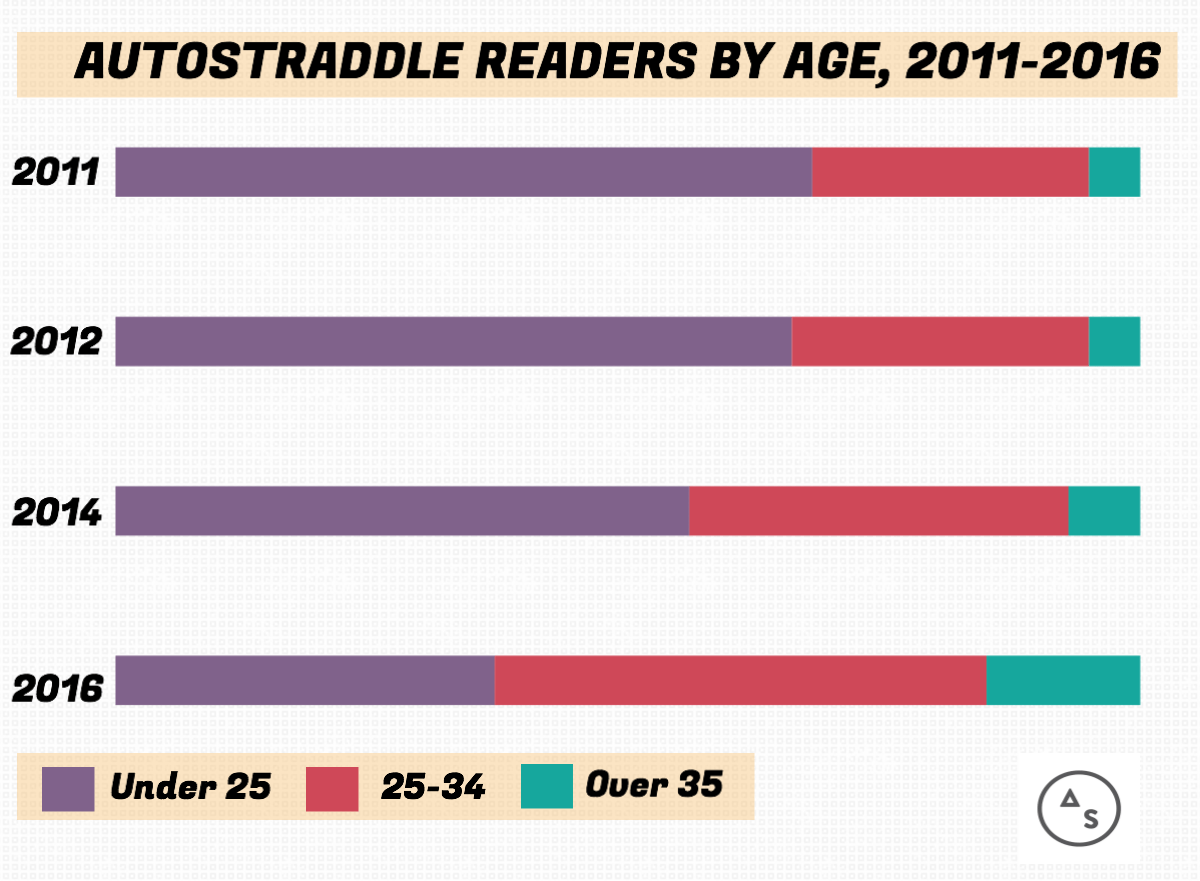
Of course, we have more readers now than we used to, so it’s not that we necessarily have a smaller number of readers under 25 than before, just that our age spread is finally starting to even out, which is great! This likely has a few causes: long-time readers getting older because that’s how time works, our site having more content relevant to older readers because Heather, Laneia and I are all in our mid-to-late 30s, and an influx of new readers from AfterEllen, who’s audience historically skewed older than Autostraddle. (Interestingly, those who’d said they came to Autostraddle on a recommendation after AfterEllen shut down were most likely to be Under 18 or over 45.)
Sexual Orientation, Relationship and Gender Identity
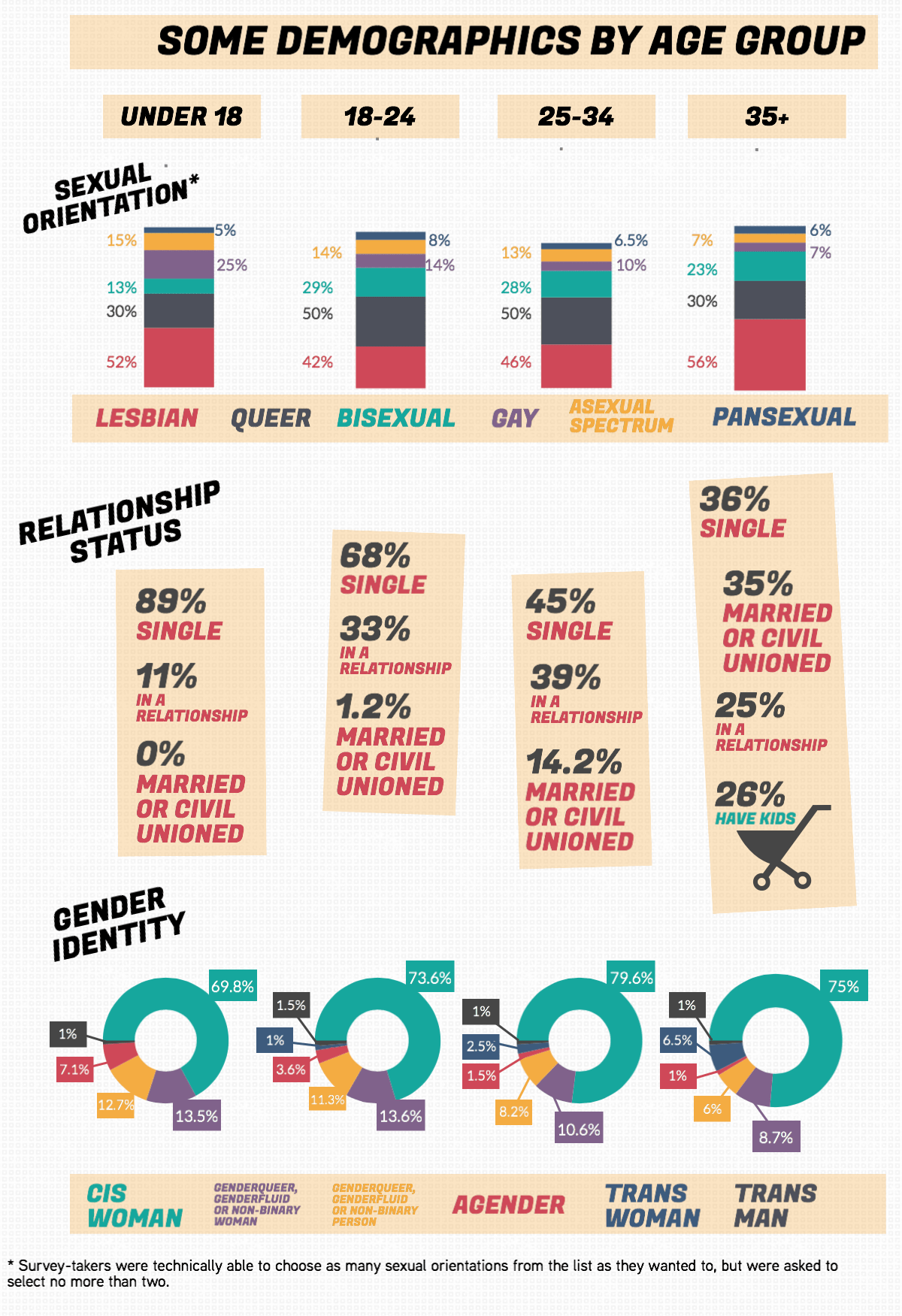
It’s interesting to think about which of these numbers reflect how different generations identify and which are revelatory of how one’s identification changes over time.
Another compelling number is the percentage of trans women increasing dramatically once we get into the over 35 group. I’ve noticed this at camp, as well — generally speaking, trans women campers tend to skew older than cis campers. I have a billion theories about this, here’s one of them: many older cis lesbians have never heard of Autostraddle and have found community in other established publications, like AfterEllen, Curve and The Lesbian Connection. But many trans women don’t feel represented or comfortable in those spaces, so regardless of their age, they end up on Autostraddle.
I’m always really intrigued by generational differences. Here’s another one: we asked about who you voted for in the Presidential primaries (WERE WE EVER SO YOUNG) and 29% of people over 35 voted for Bernie Sanders (53% voted for Hillary), whereas 51% of readers 18-24 voted for Bernie, with only 27.8% voting for Hillary.
How You Spend Your Free Time
Despite my repeated insistences that cats are problematic animals who turn a normal human home into an allergenic hellscape and that dogs are wonderful creatures you should all seek out and rescue and then let me play with, 37% of you have cats and only 27% of you have dogs! What’s going on?

I also must report that in 2014, 59% of you exercised regularly and 54% of you went to bars/clubs/lounges. I don’t know what that says about you, I’m not in charge, I’m just sharing. However, I think 47% of you will be interested to know that only 53% of you have reported “sexual activity” as a thing you do regularly.
We also asked about how you get around this life that you lead.
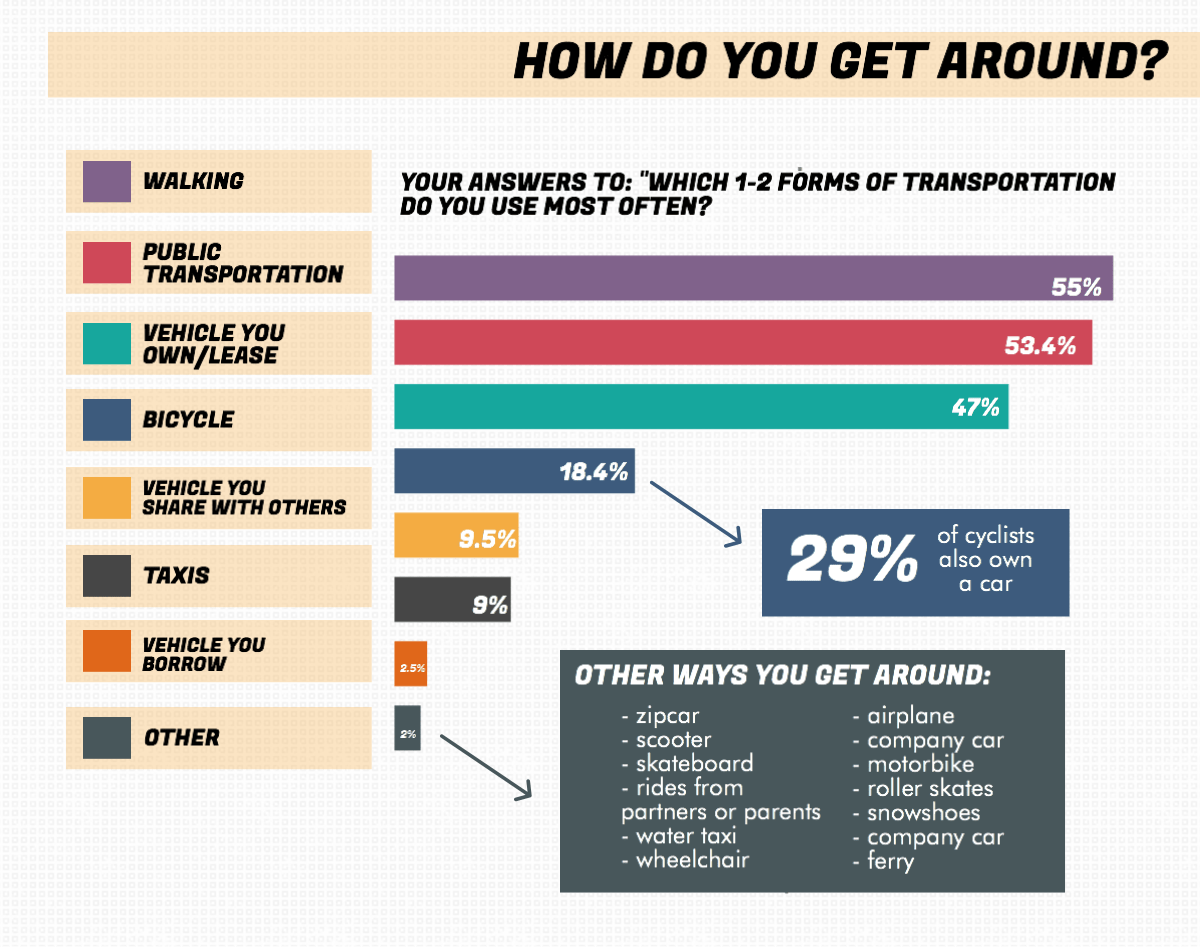
Apparently, 89.9% of American households own a car, but I don’t know what a “household” is so it’s tough to compare. 65% of U.S. residents over 25 on our survey own/lease a car, which still feels low — but also in tune with trends towards “multi-modality,” or increasing numbers of humans who take at least one walking, biking or transit trip each week, in addition to biking. Queer people are also more likely to live in urban centers, meaning greater access to public transportation and bike lanes.
We also asked about your eating and drinking activities.
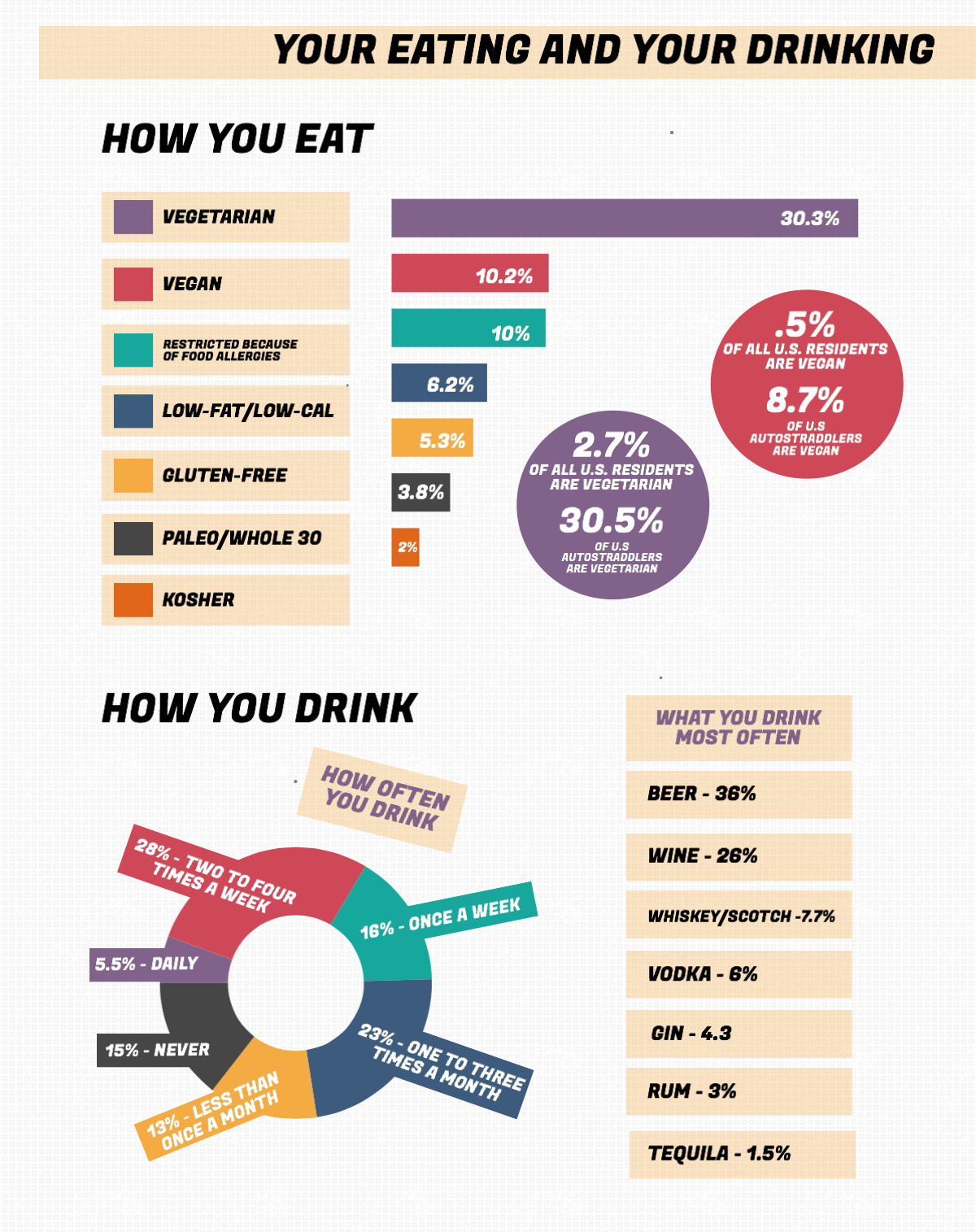
As you can see, queer women are vegetarians and vegans at truly incredible rates compared to the rest of the population, because we are nothing if not faithful to stereotype.
It’s not a secret that LGBTQ+ folks in the U.S. drink more than your average American, but there’s a lot of other demographic forces at work with our sample, too, like that you’re younger and also a lot less likely to be a card-carrying member of a religion that frowns on alcohol consumption. A mere 9.5% of U.S survey-takers don’t drink, compared to 30% of U.S. humans overall.
We also asked about marijuana usage, which turned up a bit lower than I’d expected, actually! 1.8% of you use marijuana medically, and another 3.6% are able to buy it legally where they live. 7% buy it illegally, and 9% only use when somebody else bought it and brought it.
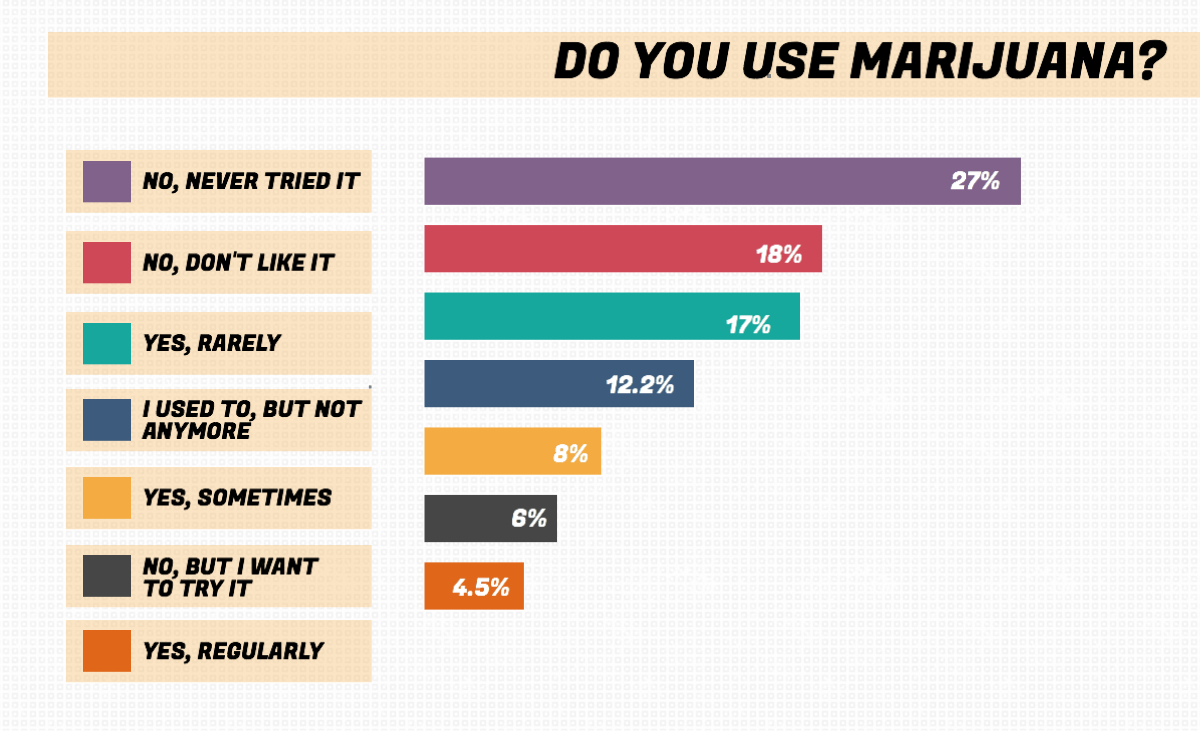
The numbers are slightly higher for U.S. residents than residents of other countries for regular use — 5.9%, compared to 4.5%. Furthermore, almost twice as many Oregon residents use marijuana regularly than residents of other areas. 32% of residents of states with legal recreational marijuana use at least rarely, compared to 29% of states without. Regular marijuana usage was most common in the 18-to-24 age group.
Whereas 52% of all adults in the U.S. report having tried marijuana, 77% of our readers have. Those of you actively using it are pretty on par with the rest of the country, though — they’re at 13%, you’re at 14%.
Work and School
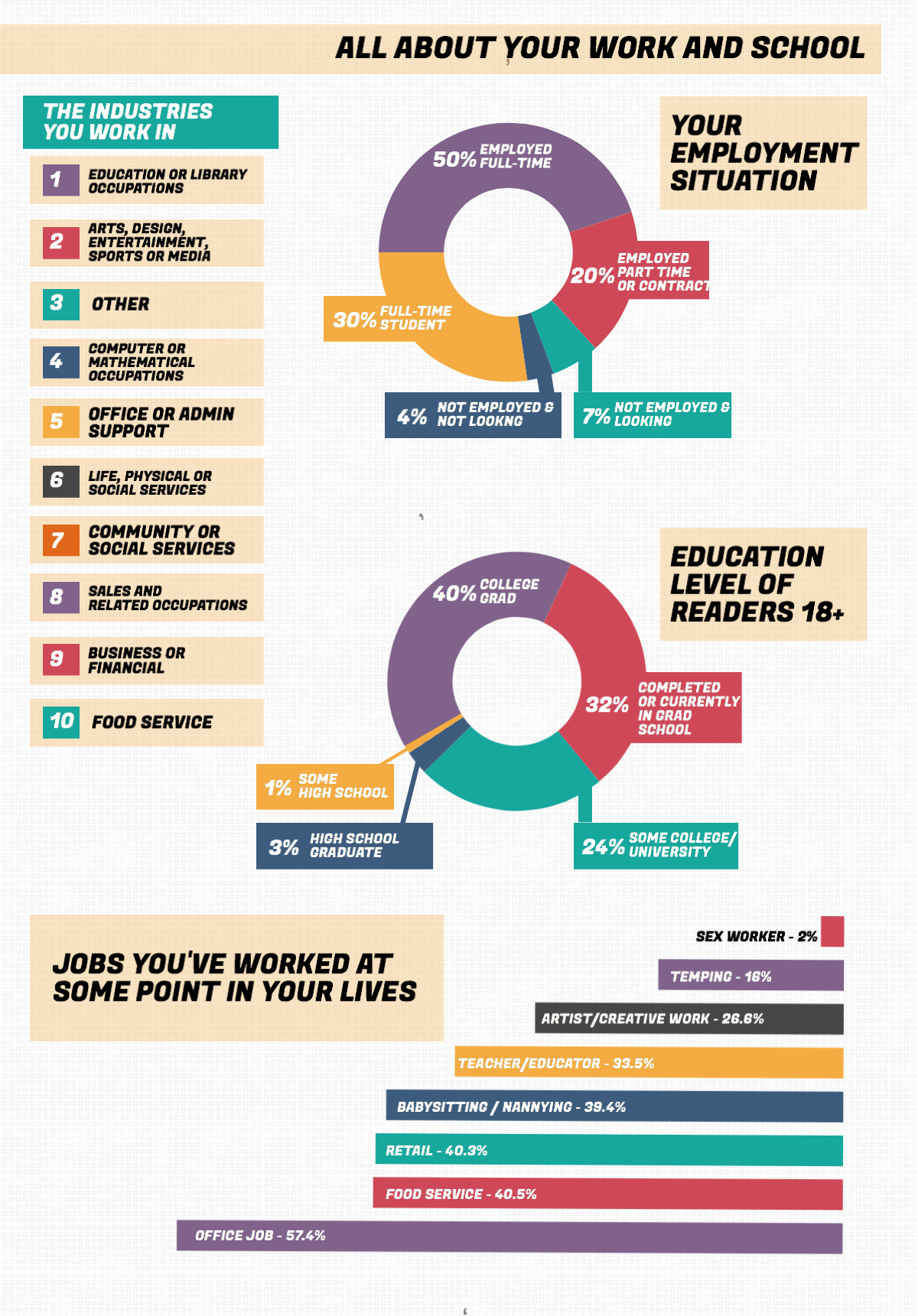
I realize looking at this “Jobs You’ve Worked” rundown that I literally made a list of every type of job I have ever worked and then was like “hey y’all, did you do this too?” There were two jobs on the list that didn’t make it onto the infographic, probably because I never personally worked them — but we had 1% and 1.5%, respectively, coming in as having worked as a delivery person for Postmates or Instacart or the like and driving for Uber or Lyft.
The Autostraddle community is, as always, disproportionately likely to seek out a post-graduate education and to work in an educational field. 47% of Autostraddle readers from the U.S. over the age of 25 have completed or are attending Grad School, compared to 12% of all U.S. residents over 25. This is probably because y’all had crushes on your teachers and therefore want to be in school forever.
Where Do You Live
64% of you live in the United States, which is also where I live. We have a really bad president right now, it’s the worst.
The “infographic” below (I’m not a designer I’m just trying to make this post kinda pretty) includes a comparison of top Straddler states versus the most populated U.S. states, which I did to show where there’s clearly an outsized or undersized proportion of queers. Namely: Massachusetts (#3 for you, #15 for the U.S.), Washington DC (#9 for you, #51 for the U.S.) and Oregon (#8 for you, #27 for the U.S.)
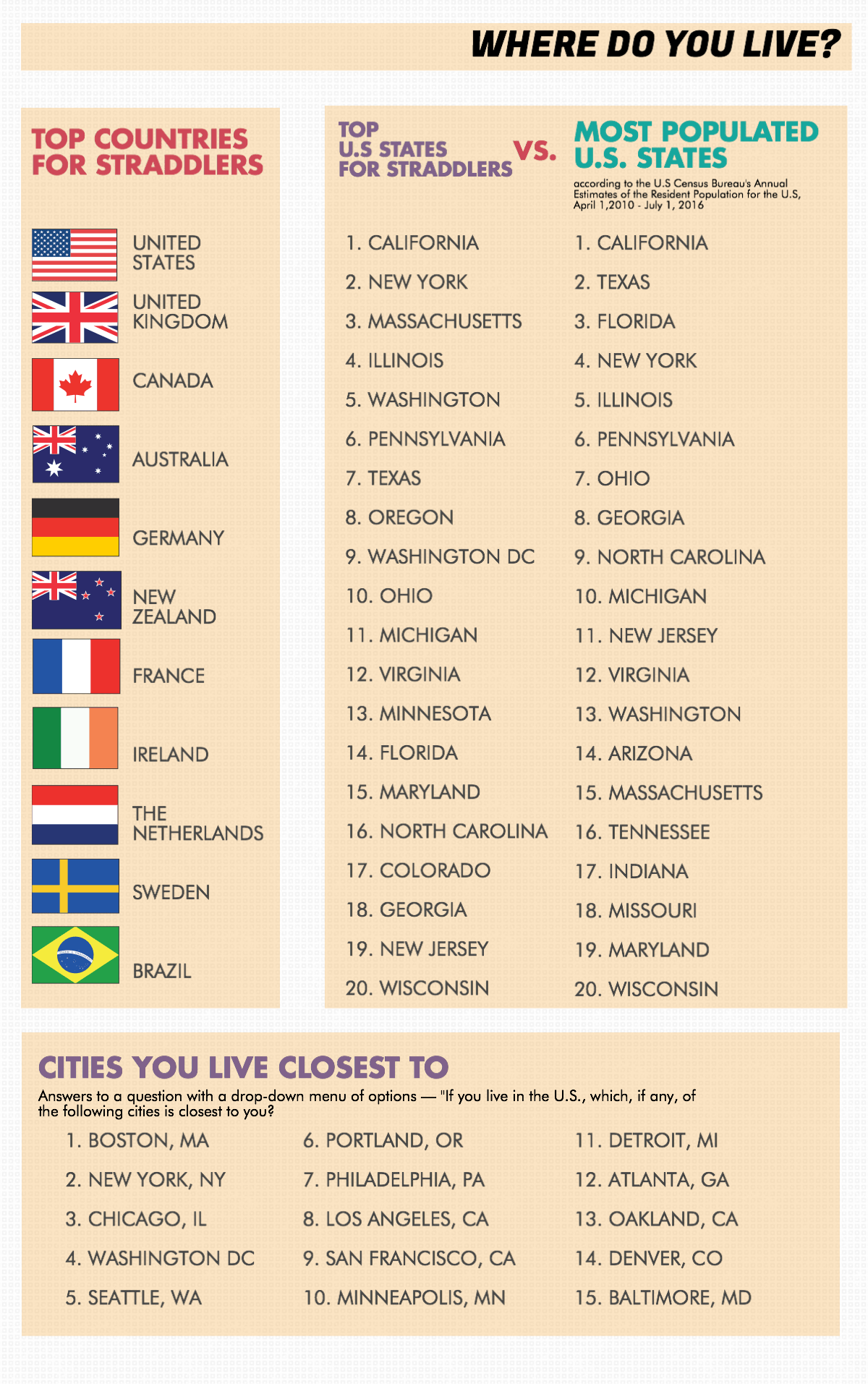
In addition to the data you gave us, Google Analytics provides us with geo-data for our users. Generally this data is a bit different than the reader surveys, as it involves readers who only read one post all year (e.g., something that went viral, thus pulling in a different demographic, or a dude looking for pics of lesbian scissoring) as well as readers who’d be around long enough to want to take this survey. But, fun fact: Google Analytics numbers are very similar to what you gave us (the U.S., UK, Canada, Australia and Germany numbers are identical!) with a few exceptions: both India and South Africa were in the Top 10 according to Google. Furthermore, The Philippines and Singapore ranked much higher on Google’s statistics than our Survey’s.
How Our Queer World Has Shifted
Some of the other questions we ask — about the sexual orientation breakdown of your friend group and how out you are — didn’t give us any data worth presenting, upon close examination. We allowed multiple responses, and it appears, for example, that some people selected “out to everybody” as well as selecting each group they were out to individually, whereas some selected “out to everybody” and nothing else. So there’s not much we can conclude from that.
I now realize it was erroneous of us to have presented this data as reliable in the past. But it wasn’t totally useless, because I did compare some of these questions to the same questions asked in prior surveys! This was interesting in and of itself:
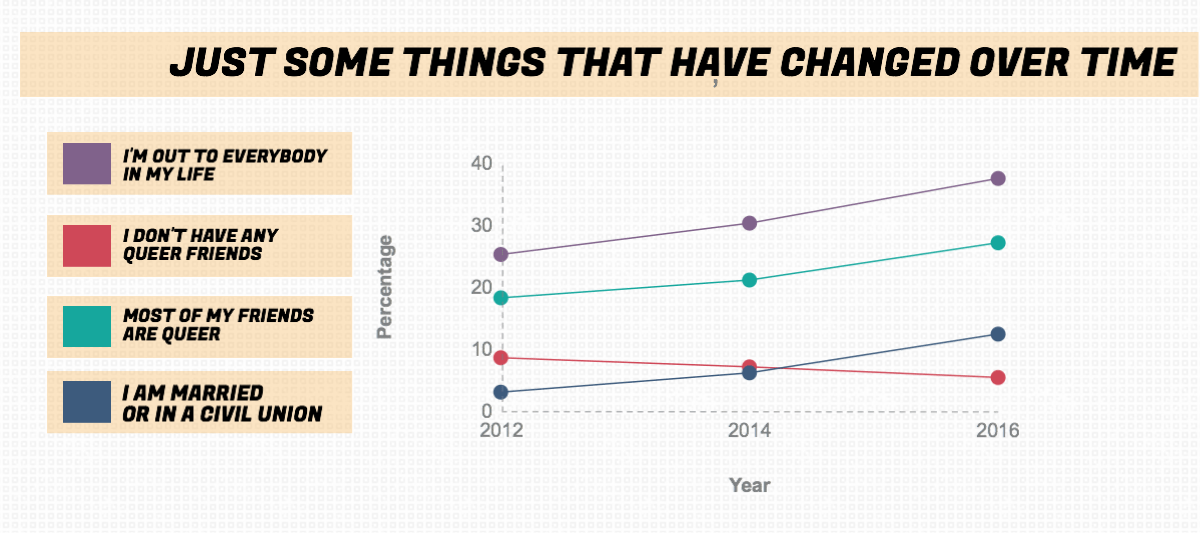
As you can see, the percentage of readers who didn’t have any queer friends at all has decreased since 2012, and the percentage of readers who are out to everybody in their life or have a mostly-queer friend group has gradually gone up. I threw marriage in there too, to show how much that has shifted since the U.S. legalized same-sex marriage.
Autostraddle Community
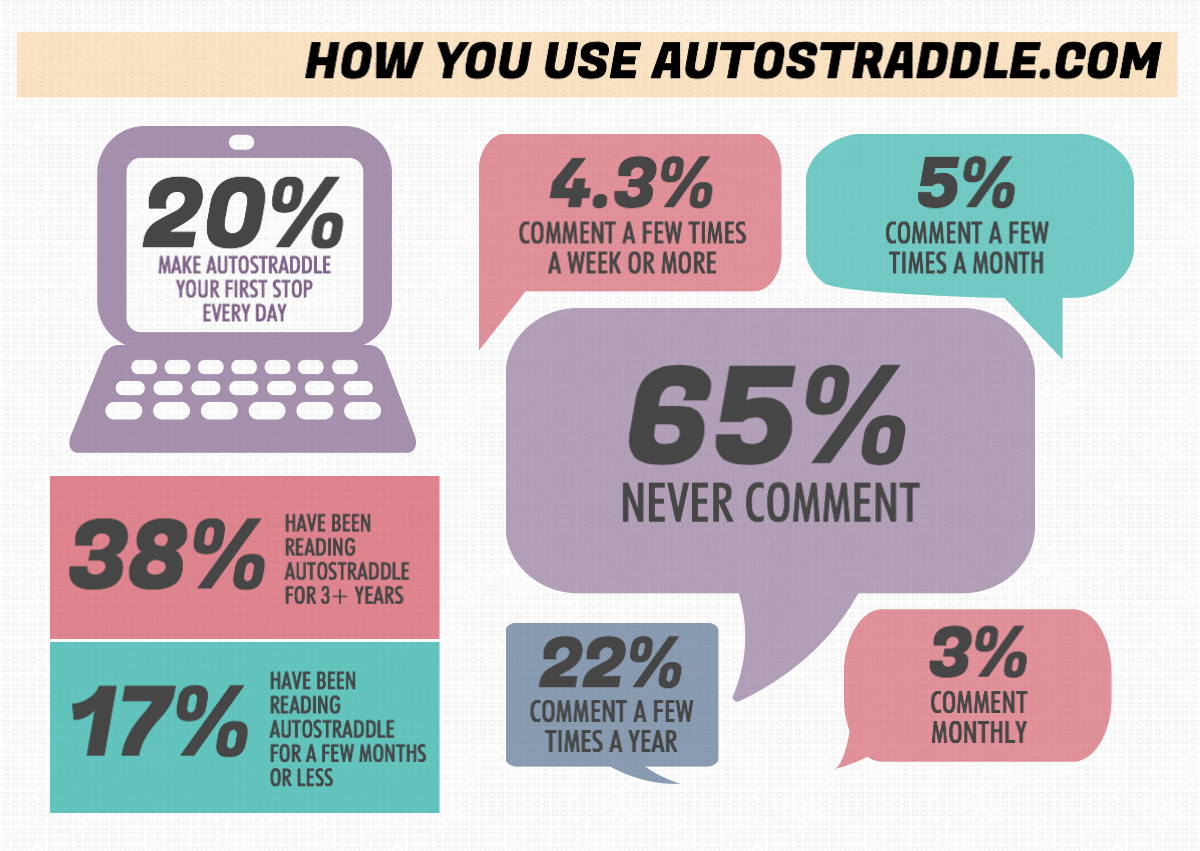
We had a higher percentage of people who’d been reading Autostraddle for a few months or less in this survey than prior surveys because it was shortly after the AfterEllen shutdown. But alas 65% of you NEVER COMMENT. These numbers are always weird for us to get (I think it was 60% in 2012) ’cause basically it means our most direct feedback, as well as other’s perceptions of what readers think of us, is based on the opinions of a mere 10% of y’all! However, we do get a lot of feedback from A+ members through the A+ Priority Inbox, and bless this survey of course.
Here’s how your support of Autostraddle shakes out:
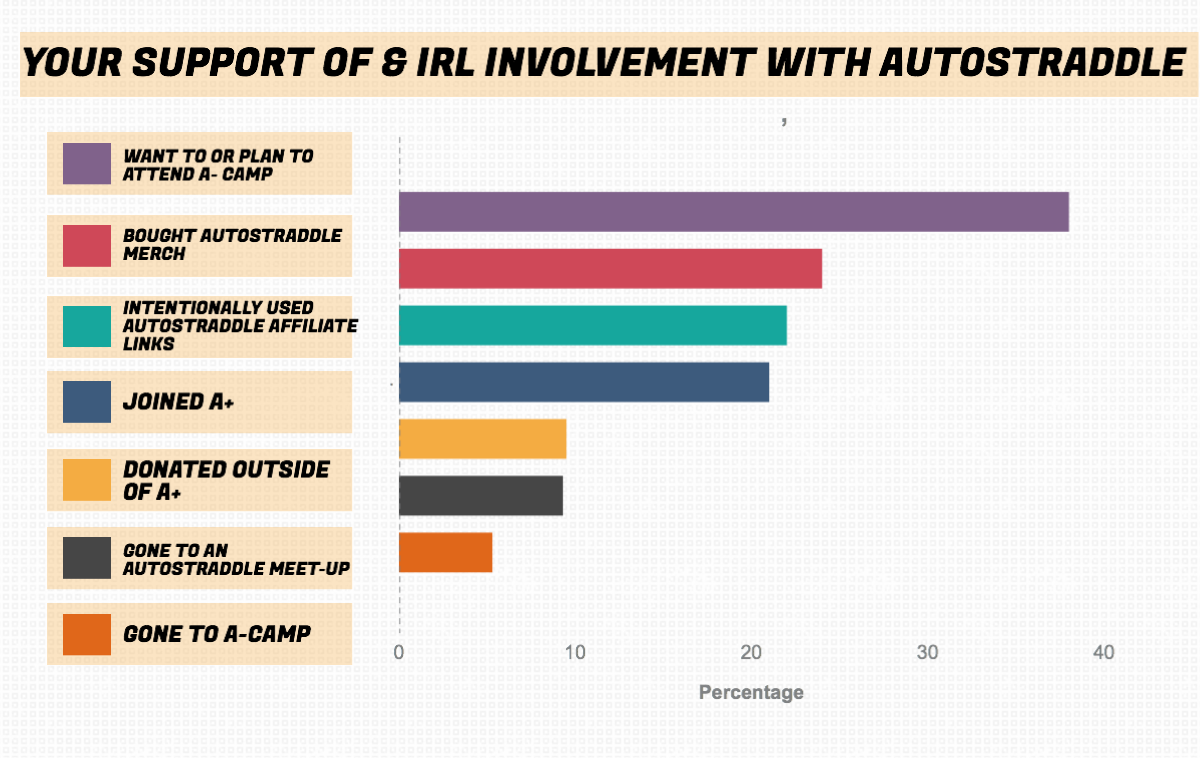
There’s definitely a perception that a significant percentage of our readership have been to A-Camp, which is fake news — only 6% of you have gone! (The actual number of humans who have attended at least one A-Camp, according to official registration data, is around 1,330.)
Here’s a preliminary fun fact from our 2017 survey — 19% of you say you’re interested in joining A+ but haven’t gotten around to it yet. I’d like to humbly suggest that you do so right now, before the heat death of the universe/Autostraddle. It’s fun, I promise! So are t-shirts and pins!
Another fun thing? Joining Amazon Prime. We get $3 for every reader who signs up for a 30-day trial via an Autostraddle affiliate link, and you can do so JUST IN TIME FOR PRIME DAY.
If you missed any of our earlier posts about the Autostraddle Reader Survey, you can catch up here:
- 55 Gayest Ways You Met Your Significant Other(s), According to the Autostraddle Reader Survey
- 39 Truly Innovative Ways You Described Your Relationship Status On The Autostraddle Reader Survey
- 35 Truly Inspirational Ways You Described Your Gender Presentation On the Autostraddle Reader Survey



Yay more people have cats than dogs! This is perfect
It’s all going according to plannnn? Muahahahahhaa!
My theory is that this is due to cats being seen as feminine and dogs are seen as masculine. That also explain why it’s ok to say one hate cats but when someone says they hate dogs it’s seen as heresy
It’s seen as cowardly to fear dogs. Yes I fear dogs but I’ve had/known people close to me have experiences that warranted it.
Cats have been more physically violent & more often but, a cat bite/scratch is only a really bad thing for a human if the cat’s got tetanus and the human’s not been jabbed against it.
My girlfriend fears cats though just because my cat growls at her and gets on her pillow…
My theory is that many of us are animal lovers who live in urban centers where a cat is easier to own than a dog. I know that in Seattle they often bandy about the statistic: more dogs in the city than children, while neglecting to mention that there are twice as many cats as dogs.
Lovely work with the survey! It’s so enjoyable to see what other readers are up to. Thanks Riese.
The 15% of folks who never drink, where are you? Can we be friends? I’ve been sober seven months now, and whether that’s true for you or not, any advice about how you never drink would be awesome. So many folks DO drink that it’s hard to be in situations where everyone is drinking or with a partner that drinks. I’m glad to know that I’m not the only one.
i was so pleasantly surprised to see that statistic! i don’t drink and i have exactly one friend who doesn’t. we made it a habit of avoiding parties and just watched disney movies a lot. it was gr8. it’s very comforting to know that there are other queer people who aren’t into the bar/club scene!
Yeah I just don’t go to bars/parties and only go to pubs for quizzes. Looking like a 12 yo boy helps too, nobody’s going to give me booze except my stepdad, who’s been letting me have bits of booze since I actually was one… Still can’t stomach a proper pint on my own.
*waves a sober hand*
Hello I am also a sober queer! 2 years as of tomorrow!
Congratulations! That’s great
Seconded. Great job!
I don’t have any advice, but I take anxiety meds that don’t mix well with alcohol plus am uncomfortable with drinking for personal reasons, and I totally understand how much social situations can suck when (seemingly) everyone else is drinking. Trying to make friends who don’t drink is almost impossible- I just want to be able to hang out with people and not worry about alcohol becoming an issue!
I wish my friends and others were at least a little more accommodating. Like you, I don’t want to worry about alcohol being a problem, but maybe at least provide something to drink that isn’t soda. Seltzer, Iced Tea, Cucumber Water, Orange Juice, something. I can party just like the next person but I do get thirsty and drinking soda makes me feel like crap.
Sober 7 years last month ;) Life has never been better.
Holy cow people. I’m so proud of us!
“So many folks DO drink that it’s hard to be in situations where everyone is drinking or with a partner that drinks.”
I feel you. I’ve been straight-edge since my teens (only thing about me that’s straight – ba-dum-chhhh) so I’ve had like 15 years to figure out how to navigate my social life as a non-drinker, but I still don’t have a lot of answers. One thing I’ve learned is that while it’s virtually impossible to outright avoid situations where alcohol is present, certain scenarios and environments put more emphasis on drinking than others. For example, I feel less uncomfortable and out of place at something like a barbecue, where drinking is more of a background thing, as opposed to a club or bar, where drinking and behavior linked to drinking often seem to be one of the main goals/focuses.
I love surveys and infographics and learning about myself, so this is just great all around!
Straddlers who don’t comment – get on that! The Autostraddle Comment Section is the Greatest (and Gayest) Place On Earth. It is the cure for ever terrible comment section on the rest of the Internet, and you can only make it better!
Seconded!
Yes! Come play with us
Wow, that was super creepy
Super interesting to have data about “queer” and “lesbian” as identities in our community. It seemed like way more teenagers were IDing as “lesbian” and not “queer” than people in the 18-34 age cohort, but I couldn’t tell if that was just who was making noise on the internet. And now there’s data! In some ways (lesbian, queer), the under 18’s look a lot more like the over 35’s than they do the 18-24 group which is interesting.
I keep seeing people on the internet trying to set those identities as opposed to each other which is always just so bizarre to me as someone who identifies pretty strongly as both queer and lesbian.
The other thing that was interesting was just how few under 18’s identify as bi compared to other years. I don’t really have a theory on that. Teenage boys are gross maybe?
Finally, I *probably* would have commented anyway because data is cool and interesting, but thanks for the reminder on the importance on commenting! :)
I wonder if fewer teens identifying as bi maybe has to do with age/experience (i.e., being younger) and also due to pervasive biphobia/bierasure? Like, maybe not identifying as “bi” because it doesn’t seem to be a valid option, but as you learn more about yourself/explore your identity some more, you begin to realize all orientations are valid and/or that maybe you identify with another more than you thought.
Idk, I’m not bi so it’s really only speculation, but I have quite a few friends who didn’t come out as/identify as bi until mid/late-20s (were “gay” or “straight” as teens) due in some combination to those two factors.
It’s really hard and confusing to figure out if you’re bi! I didn’t figure out I was bi till age 17, thanks to the confusion/denial that comes with bi erasure and the trickinesd of figuring out a non-monosexual identity. I don’t think there are fewer bi kids, they probably just don’t know yet :) could be similar with those of trans experience??
That’s a good point about bi kids hanging out other places online. As well as it being tricky to figure out if you’re bi. It really is.
I’m remembering a study or survey posted here (not conducted by AS) that found that a much higher percentage of millenials identified as bi than gen X or boomers, while the gay and lesbian categories were the same across generations.
That gave me (a genXer) so much hope for the future because it seems like increasing bi visibility is making it easier for younger people to come out as bi. I know bi erasure / is still a big problem but it’s still so much better than it was when I was 19 and the only two bisexuals I’d even heard of were David Bowie and Virginia Woolf.
I would love to hear about current teenagers’ experience with bi identity, and I’m sure it varies from place to place. I remember feeling like bi identity was accepted more than gay/lesbian identity in high school, because the straight kids felt like they could relate more easily to bi kids, and then there was a big switch when I moved into adult spaces and the reverse was true.
I also wonder if it has to do with bi identified teenagers following different media than Autostraddle, like tumblr or something? And I’m impressed at the number of teens identifying as asexual.
i realize i was in high school like ten billion years ago (the ’90s), but in my school it was actually kinda cool to identify as bisexual but identifying as a lesbian was social suicide. “queer” wasn’t even on our radar, though.
and yeah, 31% of people who identified as queer on the survey also checked off “lesbian”
Not for me in the 80s. I didn’t know anyone who was out in high school, period. And the only living bisexual I’d ever heard of was David Bowie (great singer, not very useful role model).
I did know people in college in the late 80s/early 90s who came out as bi first and gay or lesbian later.
I think you might be right. Anecdotally, I did not identify as bi until I was 26 – before that, I was “straight”, in spite of being definitely aware that I was not completely heterosexual! In my case, it was largely because of bi-erasure/internalized biphobia. I felt like I was “not gay enough” to claim a queer identity since I also liked guys.
the data about “queer” and “lesbian” was by far the most interesting part for me
I also strongly identify with both lesbian and queer!
Sometimes I identify with lesbian and sometimes I identify with bisexual, but I always identify as queer…
Some weeks I am Bi. Then others I’m lesbian and guys are off the radar. I gave up a long time ago trying to understand how my body works >__<
I came out as bisexual in college after a lot of struggling with “Well, am I gay? Or straight. I think I like boys, but only specific kinds of boys, but that’s weird and I still like girls and I definitely like the as much or more, but I can’t help feeling attracted to boys too.” (note, AMAB) It wasn’t until college that I settled into the “People are People, and I like people” attitude.
If I had to guess, the 18-24 bracket folks might identify more with being queer because of this sorting out of personal identity, a more “Eh, I dunno, but I like them.” answer to the similar questions I had. It could also be that teenagers found that labels like lesbian or gay didn’t fit them as comfortably as they first thought.
“This is probably because y’all had crushes on your teachers and therefore want to be in school forever.” I feel so personally called out.
and also because academia was the first place I had to explore queerness and where I found language to understand what was going on.
so true
Tale as old as time
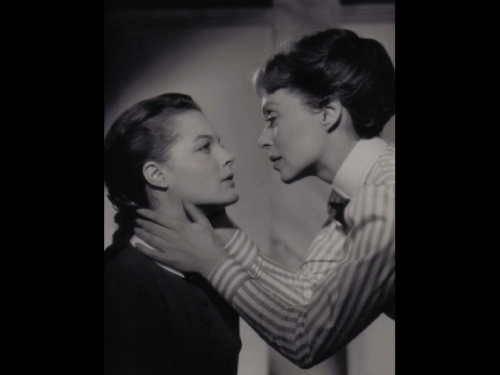
^most underrated wlw film of all time
Romy ❤️
Love this!!! How many ppl total filled out the survey, and the follow up survey? (Did you already tell us this and I just didn’t read close enough? :-/
we had around four thousand complete responses!
What about the percentage of readers who never comment but literally read every single comment?
(guilty as charged)
HI STEPHANIE I SEE YOU
Would it be too presumptuous to congratulate Stephanie on the comment award now, queer girl? Asking for a friend.
Hi Stephanie, I recognize you from the Ken photo gallery and I like your cactus shirt and I’m afraid we’re all going to have to start talking about you in the comments sections until you give in and join us.
Ahh thank you! I feel so seen <3
I've been converted and hereby swear to change my non-commenting ways.
Thank you for putting together these exceedingly pretty and informative infographics!
I love the surveys! Especially the data you can compare over time now! Wow!
Missed the mini-survey somehow, which hurts my heart. But these infographics totally rock and I just love this whole thing. Thanks, Riese!
I love seeing survey data, thank you!
A bit of feedback: I found some of the bar graphs (e.g. “How you eat”) were hard to read/difficult to understand intuitively, because of the way the category labels on the left were more broadly spaced than the coloured bars on the right – so at the top, the category label aligns with the corresponding bar, but as you go down they gradually shift out of alignment until the last bar is next to the penultimate category label, and my brain gets confused. Keeping them lined up with each other would’ve aided readability, for me at least.
oh yeah, you’re totally right — the program i use to make the infographics is really clunky about stuff like that and i’m not a designer and at some point i just had to like, accept that “perfect is the enemy of done” and move on with my life. :-( thanks for the feedback though, its good to know what people notice or not when I’m deciding when to move on
Only 39% go to bars and clubs regularly…this is why we need more queer spaces that aren’t bars! (Lovely data by the way!!)
I agree, and will also say at night too. Cause I know there are lgbtq owned shops, but some of them are only open to like 9pm maybe 10. What would be cool, would be places are open until late that isn’t a bar.
That’s what I miss most about living in Tokyo :( safe places were available 24/7 in every direction
Only 64% are from the US?
I figured foreigners would clock in at about 10%!
I’d LOVE to hear more about queer spaces elsewheres.
Like, Canada, even, or South Africa. Or Sweden, or..
Also, it really brightens my cold, dark heart, that one out of four olderstraddlers have kids and a lot of people are in relationships.
My big city Tinder world really is skewered towards the lower end on the hopeful graphics.
You know what I mean,
*.
Now that I’m a staff writer here my personal mission is to bring in news from around the world! So stay tuned :D
Awesome!
That awesome is seconded!
Please do! It can get a bit lonely out here. I would have loved to see how many of us are somewhere in Africa or Asia.
*Chants*
“Moooooooore than
1 in 3
1 in 3
1 in 3
You and you and me
You and you and sie
You and you and we”
Dear magical AS creators…
*whispers*
The chant is coming from inside the house.
For some reason I’m picturing the concierge from “Cabaret” singing this with a wink.
I love surveys and data, this post was so exciting!
There also seems to be a significant number of Straddlers in Brazil, so, like, Rio Straddlers, where are you all??????
I’m straight outta Copacabana
But I don’t live there anymore.
Oh, that’s where I live! Too bad you’re not here anymore.
Brazil one of the top Straddler countries! Represent!
Nossa, que legal! Eu adorei ler isso ???! Vai Braaaaaaasil!
The 1330 humans who have attended at least one A-Camp are the luckiest people in the world
6% vodka drinkers, cheers!
27% dog owners, woof woof!
Seeing the number of people without queer friends decrease made me smile.
I believe the aging up, I know because I’m 57, has to do with that the fact that many of us are asking questions about ourselves and as more is being written and posted we’re thinking “OMG this is me!” I’ve always suspected something was wrong with my gender, I’ve fought valiantly against coming out, but now I know who I am. It’s not easy as I’ve established a “conventional” life for myself but now I’ve come to the point where staying in the closet is not an option much longer. I and many others research and read voraciously the experiences many others share. I’ve come out to my sister, her husband, my nephew, a cousin and a niece as well a close friend. It’s very liberating and I have full support and love from everyone I’ve opened up to. I do have to tell my wife and daughter but at this point I do have some support. Hopefully my daughter will accept me and though I’m all but certain my wife will despise me afterwards it’s something I have to do. The only thing I’ve noticed as I’ve gotten older is that the need to be true is too strong to ignore and hide from.
I wish you the best of luck and lots of strength!xoxo
sending love and strength your way~
I have an unhealthy love of surveys and will fill out every one you give me.
Really interesting results here too! I was sad to see the lack of commenting… then realized I rarely comment. Going to work on that.
Thanks you all for your hard work! You know what warmed my heart most? Seeing how we all found love, and even started our own families! It gives me hope. Also, I thought it was fascinating how few of us are sexually active. That’s a huge number!
I really want to use blockquote tags here but I don’t know if they’re allowed in these comment fields.
“Another compelling number is the percentage of trans women increasing dramatically once we get into the over 35 group. I’ve noticed this at camp, as well — generally speaking, trans women campers tend to skew older than cis campers. I have a billion theories about this, here’s one of them: many older cis lesbians have never heard of Autostraddle and have found community in other established publications, like AfterEllen, Curve and The Lesbian Connection. But many trans women don’t feel represented or comfortable in those spaces, so regardless of their age, they end up on Autostraddle.”
This is a good hypothesis! I think this is a likely contributor. I’m in the 35+ category and old enough to remember when the kind of open transphobia you saw at the MWMF was more common than not. Not only has cis-het society become more accepting of LGBTQ people in general, but LGB communities have become more accepting of trans identities.
I have another not-mutually-exclusive hypothesis, based partly on my own experience and partly on what I’ve seen in trans communities I’ve been a part of: queer trans women come out later than cis LGB women and later than het trans women. (There’s some actual published data suggesting the latter is true, but it was collected by some seriously skeevy people so I don’t know how much I trust it.) For my part, I didn’t even realize I might be trans until I was 23, and it was years later that I actually started coming out to other people. Keep in mind that I’d had people assuming I was gay since high school and was very bad at pretending to be a cis-het guy so I never ended up in any serious het relationships: I still didn’t come out until my twenties. There are many trans women who are better at pretending than I was who come out in their thirties, forties, or later.
As for why queer trans women come out later, I’m pretty sure it’s straightforward stigma and lack of information, role models, and community. Queer trans women get shit for being queer, women, and trans. For het trans women, drag is a thing and has been for a long time. I’ve known multiple het trans women who started presenting femme and found their first role models and queer community in drag queens. There’s nothing equivalent for gay trans women, as cis LGB women haven’t always welcomed trans women with open arms and the cis-het world has zero tolerance for any deviation from gender norms in assigned-male people, so there’s no place for questioning trans women to explore without it immediately being high stakes. It can be a scary, lonely road. I always knew that I was attracted to women, and for a long time after I started considering the possibility I was trans, I kept hesitating because I thought that I couldn’t be a girl and be attracted to girls at the same time. This is crap, but it took me years to sort out my internalized homophobia/transphobia, find other women like me, and to really believe that being queer, trans, and female was a thing and that it was okay.
So, there are probably some assigned-male future Autostraddle readers out there in their twenties who don’t yet know they’re trans or are questioning but not yet ready to take the leap.
I would have to agree lack of information is a big one. The first time I really noticed a amab trans person who was interested in women was “Lisa the male lesbian” character from season 1 of the L Word. Even by season 5 when I re-watched that season and was in college a google search did no help. The only closest info I could find was talking to a woman/gender studies friend of mine telling me that trans women can be gay. She may have also mentioned to look up Eddie Izzard, but I’m not certain as that was a little under a decade ago.
I’m a bit muddled about the lack of cismen. Overall I like it. It’s prob why our comments are so civil generally compared to other sites (cismen aren’t inherently like it but their privilege fosters a feeling they can say bigoted stuff) & I wouldn’t want cishet guys drooling over the site, obviously. But on the other hand, I hope there’s somewhere equally as amazing & feminist etc for cis queer men to go, rather than the general meat market of stuff like grindr.
And cishet women could really benefit from some of the articles about feminism etc too.
Not going to throw a pity party for ppl who generally have the whole Internet (esp the cishet guys) but they’re really missing out cos AS is great :)
they have a lot of publications actually because gay male media is seen as a super lucrative market, so it’s not hard for even small blogs to survive financially when men are the target. queerty is a great site for example that balances gossip with meaty stuff.
also… i think there are cis queer men here, they just don’t fill out the surveys.
Ah that makes sense.
I think AS has a wide target market of ppl who aren’t typically catered to so that’s great.
It’s just so great that it’s a shame ppl don’t find it appealing to them just cos it isn’t marketed at their demographic. That’s cis guys/the effect of privilege for you, though. I don’t often comment on the articles (to avoid taking up space) but it’s those who aren’t in privileged positions that I am in that I find most interesting, as I’m not used to hearing such perspectives everywhere.
Also shout out to the queer cis guys who do read the site :)
Thanks for this! I wanted to comment about the drinking statistics. For my thesis in Grad School I actually designed a study to examine alcohol consumption among Sexual Minority Women (how I defined the population in the paper) and its relationship to different settings, expectations, motives, and minority stress. I didn’t conduct the study, (just design and create the study) so I don’t have data on any results.
Going into my thesis I wanted to look into why Sexual Minority Women have a higher prevalence of alcohol consumption and what role the community, gay bars and other things have in drinking patterns. There are a lot of theories for the increased consumption, but nothing that has solid has really been studied.
I am not sure how interested people are in the theories and different studies that have been done, but if you are interested in the topic more I would love to talk about it and/or send you some of the papers.
Yes this is very interesting
One aspect that has been attributed to increased alcohol consumption and substance abuse is minority stress which is defined as the increased stress caused by negative social attitudes and prejudice towards sexual minorities (1). Studies have found that increased specific stressors are both indirectly and directly associated with problem drinking (2). Another theory is that while not all do, many individuals come out or struggle with their sexuality during their adolescences and young adulthood which is also a time of increased alcohol consumption and that combined with the stressors may increase risk of developing hazardous drinking (3). While this explains the increase of consumption it does not explain fully why SMW in particular have higher incidences than their male counterparts.
Some studies have suggested the lesbian community has a more permissive drinking culture than heterosexual women with lesbian drinking patterns more reflective of males than straight women. Also, LB women report that alcohol is more readily available in lesbian- specific settings vs. non-lesbian specif settings (4). Some posit this may have to do with not having to conform to expected traditional female norms. This is also where the lesbian bar can come into play becuase for many people it is one of the few queer specific venues they know of, and it is essentially centered around alcohol. Lesbians were nearly 2x as likely to go to a bar 1 or more times a week than straight women (5) Several studies, mostly qualitative, have examined the role of the lesbian bar in the community.
One more thing that is being asked, but not thoroughly researched yet (at least to my knowledge) are what the drinking expectancies (what your expected outcomes from drinking) and drinking motives (the needs and functions drinking fill) are among SMW and how they differ from other populations. This is the key thing that was of importance to me because unless you know why people are drinking and what they expect from drinking, there is no way to design an intervention to address it.
I wrote my thesis in 2015, and there have been a few papers published on the topic since then but i havent had a chance to review all of them yet. I hope that helped, or was at least coherent and somewhat interesting.
1) Lea, T., de Wit, J., Reyonolds (2014): Minority stress in lesbian, gay and bisexual young adults in Australia: associations with psychological distress, sociality, and substance abuse.
2) Hatzenbuehler, M.L., (2009): How does sexual minority stigma “Get Under The Skin”
3) Parks et al (2007): The relationship between early drinking contexts of women “Coming Out” as lesbian and current alcohol use.
4) Parks, C.A., Heller R.R., (2013) The influence of early drinking contexts among adult lesbian and bisexual women.
5) Trocki, K., & Drabble, L., (2008) Bar patronage and motivational drinking in San Fransisco Bay Area: gender and sexual identity differences
Thank you for following up on it Alyssa.
This was very interesting. I had a hunch that lesbian drinking patterns were closer to males than to straight women and I have the data to prove it ha ha Ha
No problem! It’s a rare occurrence I get to use my knowledge from my thesis, so this made me feel all warm inside lol.
I’m still surprised the “free time” question didn’t ask for input on videogaming, which is a huge % of my free time. (Especially these days when I have finally convinced so many of my loved ones to join me in Overwatch!) Maybe this is a generational thing? But given how many AS’ers are in “mathematical or computer fields” I can’t believe I’m in a small minority here. Shout-out to my fellow nerdy AS folks! :D
It was a nice surprise to see Boston and Massachusetts so high on the lists of where people live/live near! HI FRIENDS.
thank u for all of this work and the rad infographics!
I love to read your article, it’s such a fabulous post. First time I read it.
I want to share the benefits of pomelo fruits.
https://www.benefitsuses.com/fruits/10-amazing-benefits-of-pomelo-fruit.html